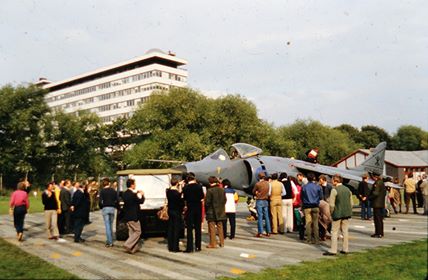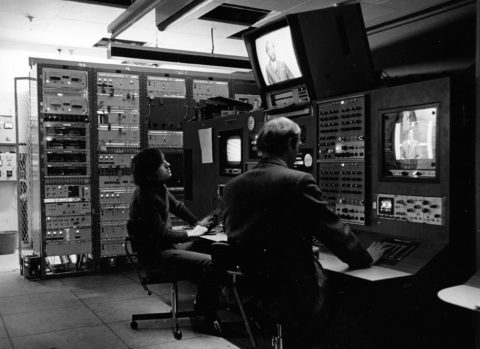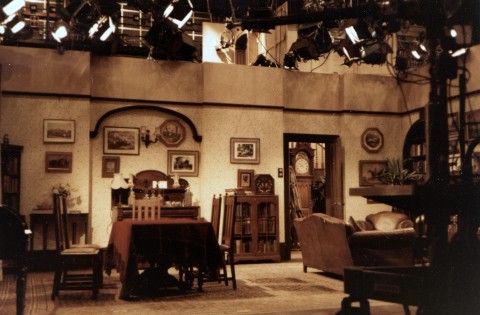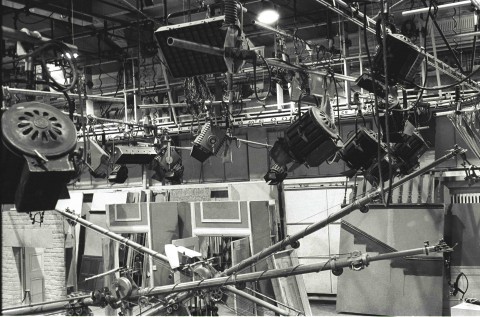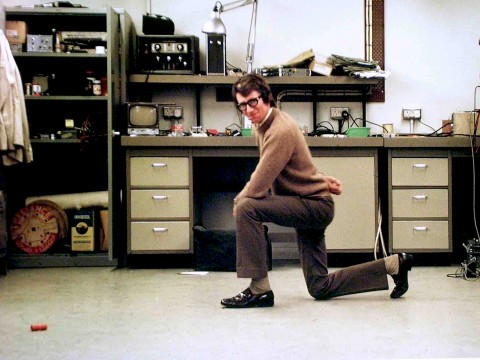Here is a photo from Keith Warrender of the landing of the Harrier in 1982, during an episode of Pebble Mill at One. It was one of director John Smith’s episodes. You’ll see the new club building visible on the right of the picture, which hadn’t been open long. Keith thinks he must have popped in to the Club for a lunchtime drink after taking this picture on an off-shift day from TAR (Technical Apparatus Room).
Tag: TAR
Colin Pierpoint blog – part 14 Working at Pebble Mill, Comms
This is part 14 of Colin Pierpoint’s blog about his BBC career:
I transferred into Communications in Birmingham in 1971 after completing the Grade C Engineering Course, and a year’s attachment to the Engineering Training Department at Wood Norton. In 1975 I got another secondment as a Lecturer for a year, and then after returning to Comms, a vacancy arose in 1977 for Communications Supervisor and I applied and got it. This was the job I really wanted in Manchester. I also had my sights on ETD, but at the time they wanted memberhip of an Engineering Institution on applications for Lecturers. I had been studying for an Open University degree with this in mind, but the OU at that time did not give the required qualification of “CEng” (Chartered engineer) at the time.
So from 1977 until 1980 I continued working as Communications Supervisor in the Comms Centre at Pebble Mill. An exciting evening was when the “Song for Europe” programme was broadcast live, with voting around the British Isles to choose the entry for the Eurovision Song Contest. Vision circuits from Manchester, Glasgow and Norwich were passing through the Birmingham Comms Centre. There was tie for first place so the regions had to vote again at short notice. Just as this was announced , I saw the Norwich picture lose sync (start breaking up on the screen). I said to one of my staff, put an extra equaliser in the circuit, and just twiddle the knobs until the sync pulse look square. He did this quickly and seconds later they cut to Norwich for their vote.
It was nice to be trusted by TAR staff (Television Apparatus Room, who adjusted the camera channels for studios A, B and C). Comms were often the only engineers in Pebble Mill in the evening and David Stevens would sometimes ask me to clear a fault. Usually I could do a tweak of the camera control unit, which I always reported to TAR staff the next day. One fault I failed to rectify: there was shading across the Midland Symbol C (the rotating world). No matter what I adjusted; iris or target volts, I could not get the image over the whole field, [for the technical readers, the monocrome output went into an inlay switcher, and parts of the image would disappear as I adjusted]. So next day the TAR staff told me what the problem was. The bulb lighting the bottom of the symbol had blown! Too technical for me I am afraid.
Colin Pierpoint
Studio Operations (part 3) – Ray Lee
Studio and camera usage
Studio A was the main drama studio, and at least initially had network drama bookings most of the time. The main drama booking days were Sun/Mon and Wed/Thurs for usually Rehearse day 1 and Record day 2, allowing for set and light on Tuesday and Saturday and sometimes a quick booking on a Friday. Studio B was used every weekday evening for Midlands Today, and briefly on a Saturday for the sport report, and on a Sunday for either Farming (the forerunner of Countryfile) and/or the Asian network programme “New Life”. Farming went out at lunchtime on a Sunday, and “New Life” was recorded on a Sunday afternoon/early evening.
Pebble Mill at One used the cameras from Studio B on Mondays, Wednesdays and Thursdays, as normally Studio A was in use for Drama. Studio A cameras were used on Tuesdays and Fridays when there were not normally drama bookings. If there were gaps in the bookings Studio A cameras were used in preference, as there was then an extra camera available. At that time Studio A had a complement of 4 cameras and a hot spare, whereas Studio B had just 3 cameras. In the earliest days the camera control unit (CCU) for one of the cameras was shared between Studio B and Studio A, which involved major re-cabling after Pebble Mill at One. By the time I moved to Studio ops, an additional CCU had been acquired, so this chore was no longer necessary. There was one additional camera and CCU in the back room of TAR, this was the “maintenance channel” and was used to repair faulty modules, and circuit boards. It was rare for it to be fully functional, and occasionally it was a case of checking whether the module or circuit board that had gone faulty in one of the studio cameras was better or worse than the one in the maintenance channel, or which might be quicker to repair! The cameras needed constant cosseting to get the best out of them, but when working well produced pictures that even against today’s cameras were very good.
Later on a further camera was obtained for Studio B which was permanently rigged in the presentation annex, meaning that there were always 3 cameras available in the studio area, and the practise of wheeling one into presentation for the end of Midlands Today was no longer needed.
Ray Lee
Studio Operations (Part 1) – Ray Lee
Staff
I joined studio operations (as part of the operations engineers “merry go round”) around July 1974. For some historical reason by that stage Studio A was entirely staffed by operations engineers 3 in the gallery and 3 in TAR, whereas Studio B only the gallery was (1 or 2 engineers), the TAR staffing being done by Comms & Engineering services staff. I suspect it was largely due to power struggles / empire building by managers on the 3rd floor trying to justify their existence. At that time Bill Berry was in charge of operations engineers as Ops Organiser, a position which a little later (1976?) John Lannin took on. The Manager Comms. & engineering services at that time was Tony Pilgrim, who in later years was replaced by Doug Taylor, and later still Frank Stevens in the early 1980’s.
Studio operations staff also rotated onto CMCR9 to staff the O.B.s although it was only a sub group who for reasons explained later were often referred to as the Mafia. The staff who at that time crewed both studio’s an O.B.’s were John Bradley, John Moore, Ron Pickering, Steve Searley, Ray Sperry, Jim Cleland, John Abbot, Elson Godbolt. John Allison was the VCMS for the scanner, and Peter Hodges and Mike Lee the VCMS (Vision Control and Maintenance Supervisor) for Studio A. In theory all 3 VCMS’s could work on the scanner, or in the studio, but in practice Peter and Mike, apart from a brief stint, stayed largely in the studio. Peter had only been appointed VCMS in early 1974, so was quite new in the job when I started working with the Studio A crew. The other Studio A engineers included myself, Dave White (who later moved to Norwich), Dennis Kiddy, John Kimberly, Peter Wood-Fisher, Ian Dewar, and Brian Jones (who did go out on O.B.s’ later- I think he was the first to break in to the select group). There may have been others, and the staff movements were fairly fluid at that time around the studios, VT and TK, although there was no real movement with regard to scanner crewing until around 1977. Jim Howarth was basically the engineer for Studio B gallery, (I don’t recall Jim ever working anywhere other than Studio B) aided by one of the other ops engineers on his days off, and Pebble Mill at One Days. Jim Howarth could very often be found in the club bar, sometimes with only minutes to go to transmission, but always seemed to manage to turn up just in time!
Ray Lee
Jim Hiscox
Copyright resides with the original holder, no reproduction without permission.
This photo was taken at Pebble Mill in April 1972.
It’s of Jim Hiscox, and was probably taken in the workshop at the rear of the original TAR (Television Apparatus Room).
Thanks to Dave Bushell and Jim Hiscox for identifying the photo.
Stuart Gandy adds the following information: ‘This was the original TAR location at the side of Studio A vision gallery. When the studio refurbishment in the mid 1980s took place TAR moved to the area above the foyer and the new ‘electronic’ graphics department occupied the original space.’
